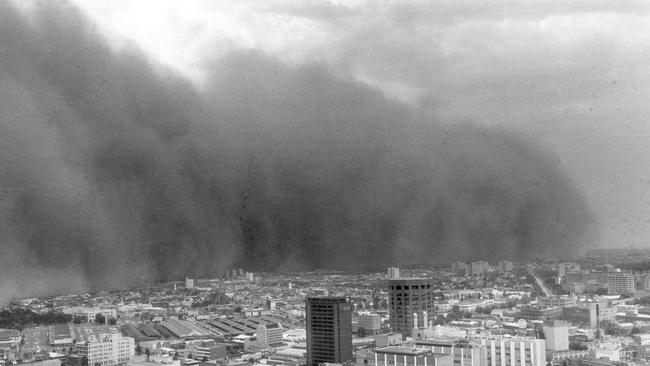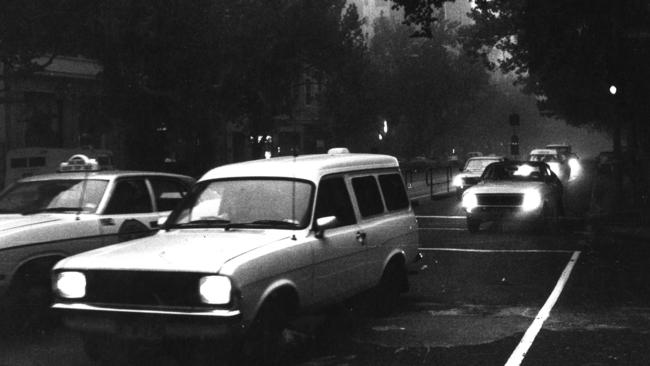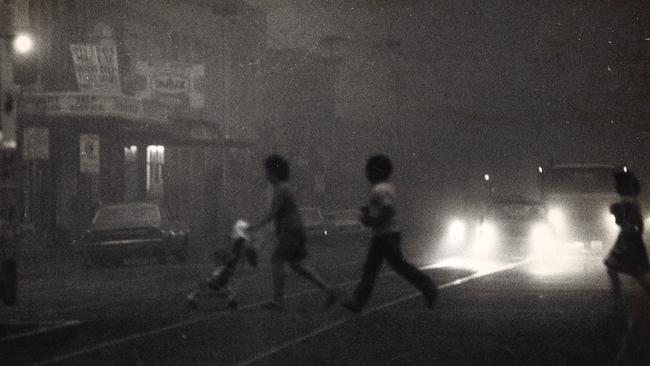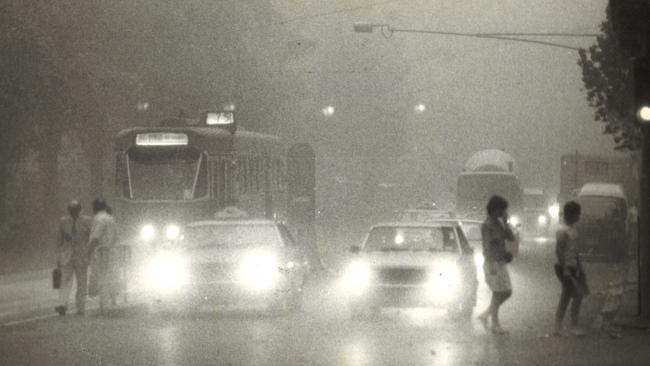This huge dust storm turned day to night in Melbourne in 1983
It was the summer of 1983 when an epic dust storm swept through Melbourne, stopping public transport, grounding flights and throwing the drought-stricken city into darkness in seconds.

VIC News
Don't miss out on the headlines from VIC News. Followed categories will be added to My News.
February 1983 was a bizarre month in Melbourne.
One of the worst droughts ever recorded had parched Victoria and gave rise to two of the state’s most memorable events – the tragic Ash Wednesday bushfires on February 16 and, eight days earlier, the dust storm that choked Melbourne in a red-brown pall.

The 1982-83 drought was among the most devastating Australia had seen.
Severe water restrictions were enforced by inspectors roaming Melbourne’s suburbs looking to book water Wallies using hoses and sprinklers.
What was then the state’s earliest total fire ban day was declared on November 24, 1982, signalling a dangerous summer that, by February, had already run Victoria’s firefighters ragged.
The day of the dust storm - February 8, 1983 - started ordinarily enough for that searing summer – another total fire ban, another sunny day and another strong, hot north-westerly wind that cranked up early in the day.

By late morning, a cold front entered western Victoria and began to march east across the state, with a cool but dry south-westerly change behind it.
In Melbourne, the temperature raced to 43.2C – a February record that was broken only eight days later on Ash Wednesday.
Bureau of Meteorology Victorian weather services manager Ted Williams said that the severe drought and classic bushfire weather on February 8 created one of Victoria’s greatest dust storms.
“That 1982-83 drought was very short but very sharp,” Mr Williams said.
“This was one of the most intense, severe droughts of the 20th century. There was practically no rain from the middle of 1982 through to February.
“It was a reasonably strong cold front but the soil was so dry and the wind got to be pretty strong ahead of the front to pick up the dust.”

The withering north-westerly wind swept up 50,000 tonnes of precious Wimmera and Mallee topsoil loosened by 10 months of drought, while the cold front pushed the vast dust cloud across the state like a giant bulldozer.
By the time it reached Melbourne’s outskirts, the dust storm was 500 kilometres wide and 100 kilometres thick and was travelling at 90km/h.
It was an ominous sight as it roared towards the city.
At 320 metres high, it swallowed even the tallest buildings in the CBD when it hit there about 2.55pm.

Instantly, the streets went dark as the dust cloud blotted out the summer sun.
People caught outdoors ran for cover in doorways to escape the thick, choking pall.
Visibility was reduced to less than 100 metres in seconds.
The sudden darkness caused some street lights to switch on, and motorists turned on their headlights in a bid to cut through the cloud.
At Moonee Valley, 3UZ racecaller Bryan Martin told listeners: “People in the Wimmera, if you’re looking for Dimboola, it’s now being blown over Moonee Valley”.

The airports at Tullamarine, Essendon and Moorabbin were shut for more than half an hour and four domestic jet flights were diverted.
The circus came to town, but left very abruptly in Dandenong when the Sole Brothers’ Circus big top blew away, causing $250,000 damage and forcing the troupe to abandon its remaining shows there.
The gusty change tore the roofs off at least 50 houses in the metropolitan area and uprooted hundreds of trees.

Downed trees blocked several suburban railway lines, while the Vic Rail reported that the dust had unexpected effects on country locomotives.
“The dust seems to have gotten into them and they’re spluttering and carrying on,” a spokesman told the Sun News-Pictorial.
Blackouts were common across the state as the wild weather hit, downing powerlines and coating insulators and wires in thick dust.

For 10 minutes as the dust billowed across the city, Melbourne’s Telecom exchanges were overloaded as panicked Melburnians rushed to phone loved ones or mistakenly report the outbreak of bushfires.
With home air conditioning a luxury for most, windows opened for ventilation on the stifling day instead allowed the unwelcome visitor from the north-west to coat their furnishings in fine powder.
The worst of the storm was over in less than an hour, although the now overcast sky was stained brown for the rest of the day as the dust settled.

For people on the land, though, the damage was far more profound.
The Victorian Farmers’ Federation said it would take 10 years and tens of millions to rehabilitate the land and assist farmers already at breaking point because of the drought.
The dust also left an indelible mark on the memories of everyone that witnessed one of Melbourne’s strangest weather events.
MORE NEWS:
